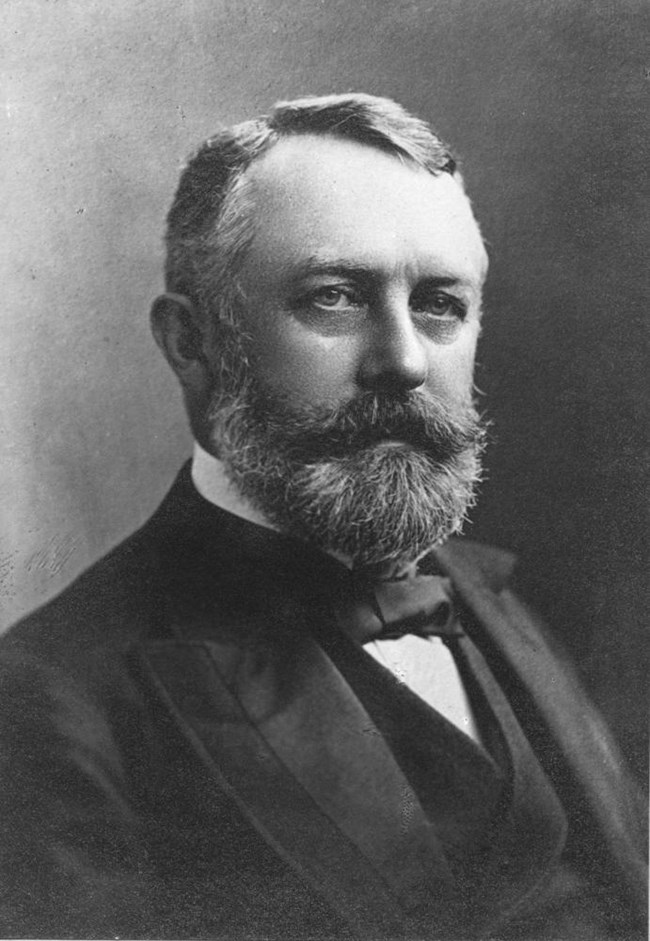
Henry Clay Frick Papers A founding member and perhaps one of, if not the most famous, member of the South Fork Fishing and Hunting Club; perhaps second only to Andrew Carnegie. The following is from: Historic Structures Report Appendices: Clubhouse, Brown Cottage, Moorhead Cottage, Clubhouse Annex written for the National Park Service. "Henry Clay Frick was born December 19, 1849 in West Overton, Pa., a fourth generation American of wealthy parentage. The second of six children, he was named for the Whig leader and Kentucky Senator Henry Clay. Receiving his formal education in the brief span of thirty months (in 1864 and 1865 Mt. Pleasant Institute, and for ten weeks at Otterbein College in Ohio in 1866), Frick entered the business world as quickly as possible. After a short stint as a salesman in Pittsburgh, he returned home to serve as a bookkeeper in his grandfather's distillery, A. Overholt and Company. In 1871, Frick founded the coke company that would bear his name. Having survived the Panic of 1873, Frick sought to expand his business, having acquired additional funds by brokering the sale of a local railroad to the Baltimore and Ohio Company for $50,000. His company flourished, and by the age of thirty, Frick had already become a millionaire. In 1882, Frick reorganized the firm into H.C. Frick Coke Company with two million in assets and a stock issue of 40,000 shares. Soon after his marriage to Adelaide Childs (in December 1881), Frick became acquainted with steel magnate Andrew Carnegie, beginning a long business relationship. In 1889, Frick was entrusted with the reorganization of Carnegie Brothers Steel, and soon orchestrated the consolidation of several companies into the Carnegie Steel Company. In 1895, Frick relinquished control as corporate manager, giving greater autonomy to the newly created position of president. In 1897, however, he and Carnegie became embroiled in a dispute that threatened to end their relationship. Though James Reed [a Club Member] helped broker a resolution, their relationship was never the same, and they remained estranged until their deaths. In 1900, though J.P. Morgan consolidated both Carnegie Steel Co. and H.C. Frick Co. (as well as other companies) into U.S. Steel, and Frick became a director of the corporation. The position was in reality the final post in Frick's remarkable career. Frick's philanthropic activities are too numerous to catalog, although it should be noted that he left behind after his death an art collection virtually unmatched in this country. Among other charitable actions, Frick bequeathed a sizable park to the city of Pittsburgh and gave liberally to Princeton University. Frick was father to four children: Henry Clay, jr. [sic], who died in infancy; Martha Howard, who died prematurely in 1881; Helen Clay; and Childs." (Historic Structures Report Appendices: Clubhouse, Brown Cottage, Moorhead Cottage, Clubhouse Annex, p. 387) Henry Clay Frick is probably most infamous for his role in the Homestead Strike. In July of 1892 workers at the Homestead Works of the Carnegie Steel Company, went on strike because they wanted to organize, something that Frick adamantly opposed. Until they refused to come back to work, Frick locked the workers out of the mill. On July 5, 1892, 300 Pinkerton detectives were brought in to guard the mills surrounded by what workers dubbed "Fort Frick." The workers and the Pinkertons clashed and the "Battle of Homestead," as it was called was only quelled by the intervention of the Pennsylvania State Militia (National Guard). Many workers were killed; many more were injured. Frick's actions in the Battle of Homestead resulted in an attempt on his life. On Saturday, July 23, 1892, Frick and Carnegie Steel vice-president, as well as member of the South Fork Fishing and Hunting Club John G.A. Leishman were having a conversation in Frick's office when all of the sudden there was a commotion at the office door. Alexander Berkman, native of Worcester, MA, influenced by social reformer Emma Goldman, had come to pay Mr. Frick a sinister visit. At first Frick was annoyed, but then became fearful when Berkman pulled a revolver and took a shot at Frick. Frick fell to the floor, then Berkman aimed the gun again between Frick's shoulder blades. Leishman jumped to action and forced Berkman to shoot off aim. Frick was wounded in the neck and two stories exist about what happened next: 1.) That a company carpenter struck Berkman in the back with a hammer. 2.) That when Berkman's next shot did not go off, the wounded Frick and Leishman went after Berkman. Berkman was apprehended by the local sheriff. When the doctor was summoned, Frick refused anesthesia and assisted the surgeon in probing for the bullets. Frick died on December 2, 1919 in New York City. |
Last updated: December 6, 2024
